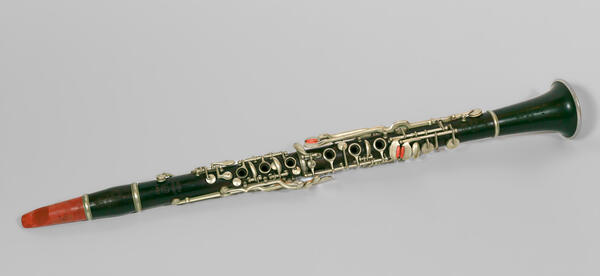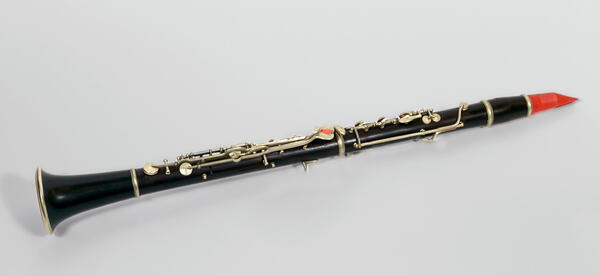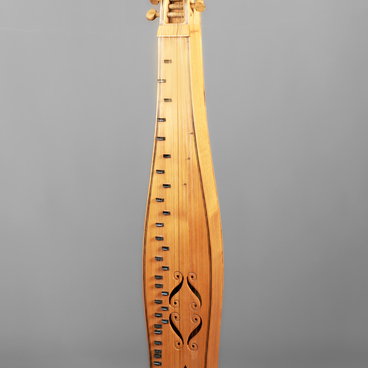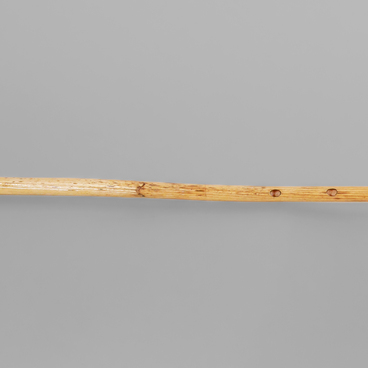In 1966, the Moscow State Conservatory donated an “A” clarinet and a “B♭” clarinet to the Museum of Music. Both these clarinets were produced by the “C. Kruspe” company in Erfurt, Germany in the first quarter of the 20th century. These two instruments have slightly different tone color which is why they complement each other.
The larger clarinet in “A” has a darker and mellower sound. The clarinet consists of five detachable components: a mouthpiece with a single reed, a barrel, an upper joint, a lower joint, and a flared bell. On the front side, the clarinet is equipped with fourteen keys, including three open keys, and six tone holes that are covered with fingers. On the back side, there is one tone hole for the left thumb.
This clarinet used to belong to Sergei Rozanov (1870–1937), a Russian clarinetist, a teacher at the Moscow Conservatory, and an Honored Artist of the RSFSR. He is considered to be the founder of the modern Russian clarinet school.
Sergei Rozanov was born in Ryazan. He started learning the clarinet at the age of twelve and was taught by his father, an amateur musician. During the entrance examination to the Moscow Conservatory, the sixteen-year-old Rozanov won the hearts of the admissions committee members with his virtuoso performance of the “Fantasy Pieces” by Robert Schumann.
At the conservatory, Rozanov studied the clarinet under Franz Zimmermann, professor and musician at the orchestra of the Bolshoi Theater, and took up chamber music under Sergei Taneyev. Rozanov graduated in 1890 with the Great Silver Medal which was the highest award because the students of wind instruments were not awarded Gold Medals during that period.
Between 1889 and 1894, Sergei Rozanov performed as a soloist in different theaters of Moscow, Ukrainian opera, Italian opera, and “Pryanishnikov’s Russian Opera.” For 35 years (until 1929), Rozanov was the main solo clarinet of the Bolshoi Theater.
Pyotr Ilyich Tchaikovsky and the conductor Arthur Nikisch admired Rozanov’s performances. Sergei Rachmaninoff was so delighted with his proficiency that he even wrote clarinet solos specifically for Rozanov — one in the second movement of the Piano Concerto No. 2 and one in the third movement of the Symphony No. 2.
The larger clarinet in “A” has a darker and mellower sound. The clarinet consists of five detachable components: a mouthpiece with a single reed, a barrel, an upper joint, a lower joint, and a flared bell. On the front side, the clarinet is equipped with fourteen keys, including three open keys, and six tone holes that are covered with fingers. On the back side, there is one tone hole for the left thumb.
This clarinet used to belong to Sergei Rozanov (1870–1937), a Russian clarinetist, a teacher at the Moscow Conservatory, and an Honored Artist of the RSFSR. He is considered to be the founder of the modern Russian clarinet school.
Sergei Rozanov was born in Ryazan. He started learning the clarinet at the age of twelve and was taught by his father, an amateur musician. During the entrance examination to the Moscow Conservatory, the sixteen-year-old Rozanov won the hearts of the admissions committee members with his virtuoso performance of the “Fantasy Pieces” by Robert Schumann.
At the conservatory, Rozanov studied the clarinet under Franz Zimmermann, professor and musician at the orchestra of the Bolshoi Theater, and took up chamber music under Sergei Taneyev. Rozanov graduated in 1890 with the Great Silver Medal which was the highest award because the students of wind instruments were not awarded Gold Medals during that period.
Between 1889 and 1894, Sergei Rozanov performed as a soloist in different theaters of Moscow, Ukrainian opera, Italian opera, and “Pryanishnikov’s Russian Opera.” For 35 years (until 1929), Rozanov was the main solo clarinet of the Bolshoi Theater.
Pyotr Ilyich Tchaikovsky and the conductor Arthur Nikisch admired Rozanov’s performances. Sergei Rachmaninoff was so delighted with his proficiency that he even wrote clarinet solos specifically for Rozanov — one in the second movement of the Piano Concerto No. 2 and one in the third movement of the Symphony No. 2.





